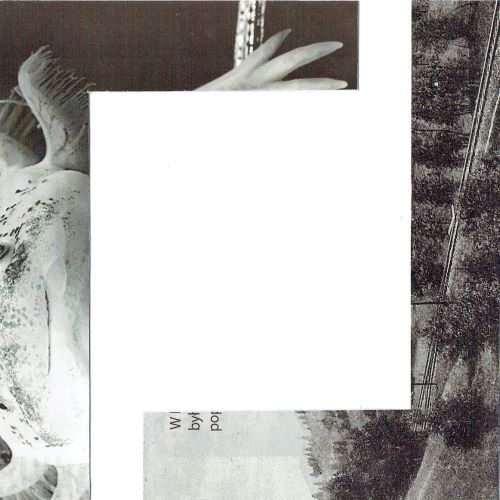
One of the first posts on this blog was dedicated to the Danish art platform that has been establishing itself over the last decade Sigrids Stue (Sigrid’s Living Room), set in the multicultural context of the Gellerupparken neighbourhood in Aarhus. It enables artists, architects, and activists to implement local action strategies that give alternatives to the capitalist paradigm of urban development. In this case, these actions are an expression of the critical attitude of their authors towards the revitalization of this area, which has been carried out for several years. Sigrids Stue’s team represents an interdisciplinary, geographically, culturally, and age-diverse context and consists of eight to ten people. (More information can be found on the website of the platform.) Not wanting to repeat the content signaled earlier, I refer you to the post from June 28, 2019. This time I took the opportunity of my short artistic residency at Sigrids Stue in February to gather information about the current stage of this interesting project.

Covid
We now exist in the aftermath of the extremely difficult period following our new covid reality. Different ways of working meant that cultural institutions closed their spaces, and activities migrated to the Internet where they did not necessarily experience satisfactory results. When I ask the members of the project about this time, I find that, paradoxically, it was a very interesting period that provided the additional drive for their development. Partly because, not being able to travel, they could devote more time and energy to local activities. „I must say that we have been very active during covid. We kept our meetings, initially online, but after a while we realized that we had to meet in real life – outside, keeping our distance from each other,” recalls artist Grete Aagaard.
Lars Henningsen, whose achievements include many interesting artistic projects in the field of children’s play culture, responded quickly to emerging situations to propose creative activities that children living in the neighbourhood could pursue in their apartments. He prepared „tool bags” enabling independent creative tasks to be explored alongside various techniques. He delivered them to the participants’ homes, and then stayed in touch with them by phone, advising, discussing, and curating the execution of the works.
Another project that emerged around this time was „NetWork”, discussed online with London-based architect Carl Fraser, architect Muhammad Ejle, and landscape architect Jennie Schneider. It was an attempt to visualize the way people work together in the local space. It began with remote interviews with people belonging to the team’s network of contacts, and then took the physical form of a network made of ropes dyed in various colors with extracts from herbs growing in the area. As Ambra Molinari says, „it was a reflection on the invisible structure connecting independent organizations, on the essence of collaboration, and the shape it takes”.

When, after a year and a half break, Carl was finally able to re-engage with the residence, he implemented the „Mapping Gellerup” project on site, which was a visual representation of a timeline containing both past and current initiatives in the field of social, cultural, and political life that took place simultaneously in Gellerup and globally.

The period of the pandemic was also the time when the Danish artist Camilla Nørgård, in cooperation with Sigrids Stue, was realizing her site-specific work „Omsamling Gellerup” („Reassembling Gellerup”), intended for the newly built building of the Child and Health Center. It had the form of a collage of elements collected in the area. Located outside, you will find a juxtaposition of artificial and natural stones collected from various locations. Inside, it was a wall-mounted composition of fragments of furniture and interior furnishings that had disappeared from the spaces of the neighbourhood because of the demolition of buildings. The final form of this installation was completed last autumn.
Relocation
As the covid epidemic’s first attack struck in 2020, Sigrids Stue’s main project The UdeStue had to move. It is a set of containers adapted to facilitate workshops. The Sigrids UdeStue (Sigrids Stue’s outdoor living room), was initially located beside the (still to be built) Karen Blixen Boulevard. At the time, it was a pioneering space. All around was the desert of a construction site. On the other hand, The UdeStue was located along a daily route of passers-by, so it was easy to initiate social contacts, which was crucial for this project.
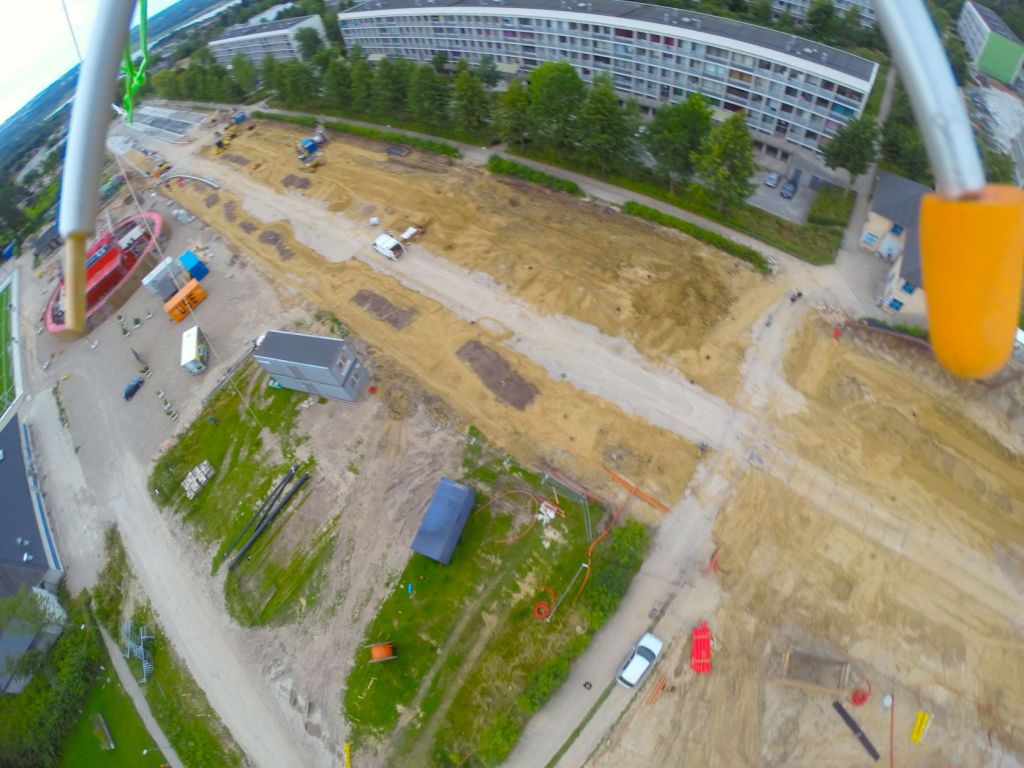
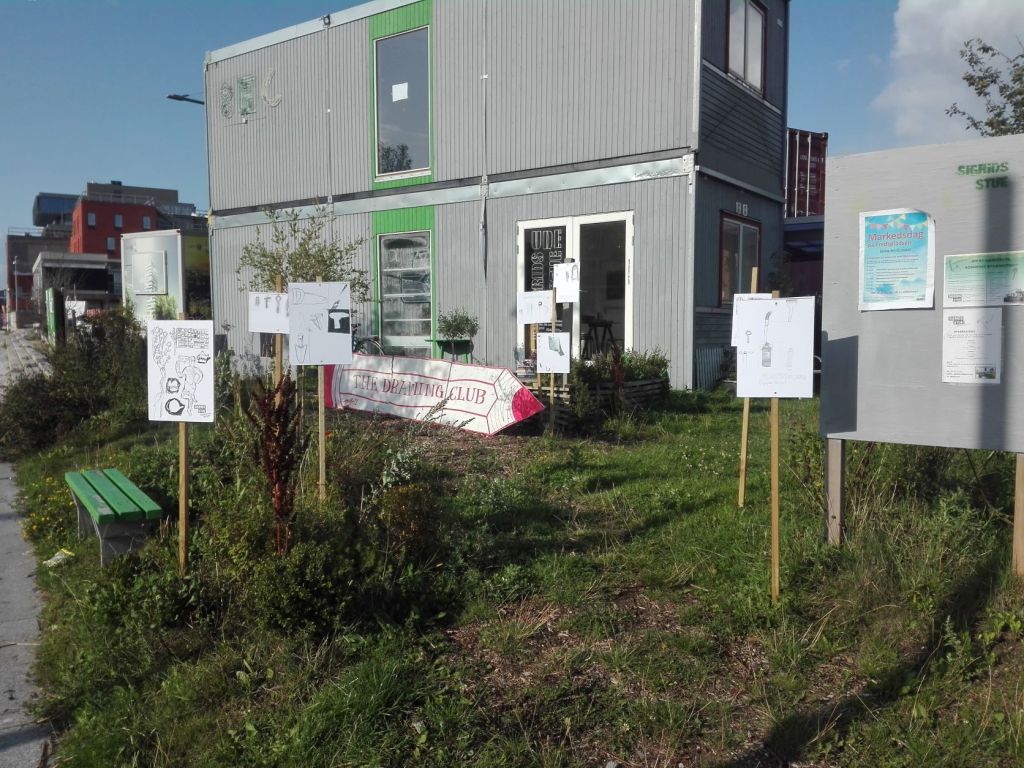
Over time, however, when the boulevard took its final shape, it began to overgrow with new buildings, both offices, and public ones. And so, in place of The UdeStue, a library was provided. The Sigrids Stue team received a new location – a slightly larger plot, able to accommodate more containers. The visual anthropologist Ambra Molinari in this way described the way their team operates there: „It’s about presence and recognition. We were working at an intersection where nothing was planned, so we could intervene in this place and take care, and make it an inviting place for everyone to enjoy and to be around”.
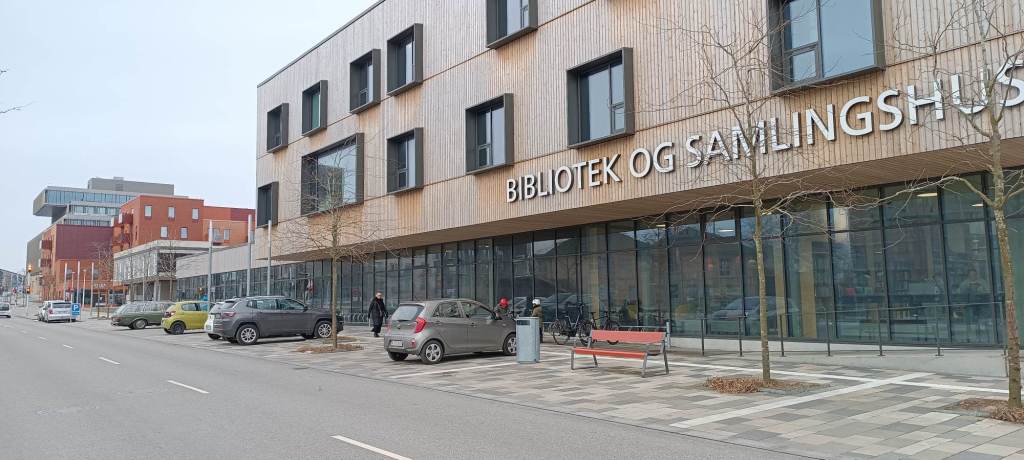
There, Lars carried out his processual project „Plantesanatoriet” („Plant Sanatorium”), collecting abandoned shrubs and trees from Gellerup and Aarhus. Speaking about The Sigrids UdeStue, the artist notes: „One of the main themes there is presence: the plants, the house, people being there, saying ‚Hallo’, doing tasks again and again. A lot of people can see what we are doing and see that we are doing things in quite another way, in another social structure, and yet they are recognizable. I think the point is that plants and people are being very visible down there”.

Gellerup Art Factory
However, when I am in Gellerup in February, Sigrids Stue has chosen to temporarily move to Gellerup Art Factory’s space in the new Sport and Culture Campus at Karen Blixen Boulevard. It is an organization having a structure of an umbrella spread over five cultural projects operating in the estate. Sigrid Stue is one of them. During the three winter months, it has used a large, heated, and well-equipped room. The team members emphasize that this situation has its good and bad sides. The advantages are that they can more actively contribute to the collaboration with the Gellerup Art Factory in the area and try their praxis out in different settings. On the other side, they are not in contact with as many passers-by as when they are working in The Sigrids UdeStue.
Evolution of the idea
Observing the current way of functioning of this project, I can see its evolution. A few years ago, its main goal was to organize artistic residencies, in which artists carried out their activities, critically referring to the gentrification process, which they could observe at their fingertips. Currently, members of Sigrids Stue’s team create critical projects embedded in the local context themselves. They also invite external artists and architects to their processes from time to time.
Grete Aagaard emphasizes the collaborative nature of Sigrids Stue: „We are as much participants in what happens in the area as the inhabitants are participants in our project. It is more about creating something together. People that pass by the UdeStue can furthermore be engaged even without our presence there. People can come and sit on the terrace or pick herbs, jump on the stones, visit the Plantsanatorium, etc”.

Action
A clear example of the team’s collaborative method of operation is the action „Finder Sted” (this title is a word game in Danish, it means both „to find a place” and „something that happens”) initiated by Lars Henningsen. It consists of several stages. One of them was a presentation of prints made on transparent foil, showing the old plans of Gellerupparken, as well as photos of the area, made with a camera attached to a kite. Overlapping the prints on top of each other made it possible to visualize the changes that had taken place in this space – demolition, construction of new structures, felling of trees, etc.
During my residency, the next part of this project was coming about, so I took part in it on an „all hands on deck” basis. Its essence consisted in juxtaposing two realities. The first of them, existing in the physical dimension, is the Municipal Library, whose newly built seat is located at the centrally located Karen Blixen Boulevard. The second reality has an ephemeral character. It refers to the previous place where The UdeStue was located and functions in the memory of its users.
The plans of both buildings overlap. Therefore, based on a drawing made from memory by Ambra Molinari, we recreated the outline of The UdeStue from slats in a 1:1 scale, placing it partly on the floor of the library and partly outside its walls. In this way, we tried to show how the new building becomes another layer, covering someone’s previous experiences. Lars says he wants to have the right to demonstrate publicly: „we were present in this place at that point and had a lot of meaningful experiences together within Sigrids Stue’s team, and people from the area that were involved”. Because, as he claims, people quickly forget the processes taking place in space and feel distanced from them.
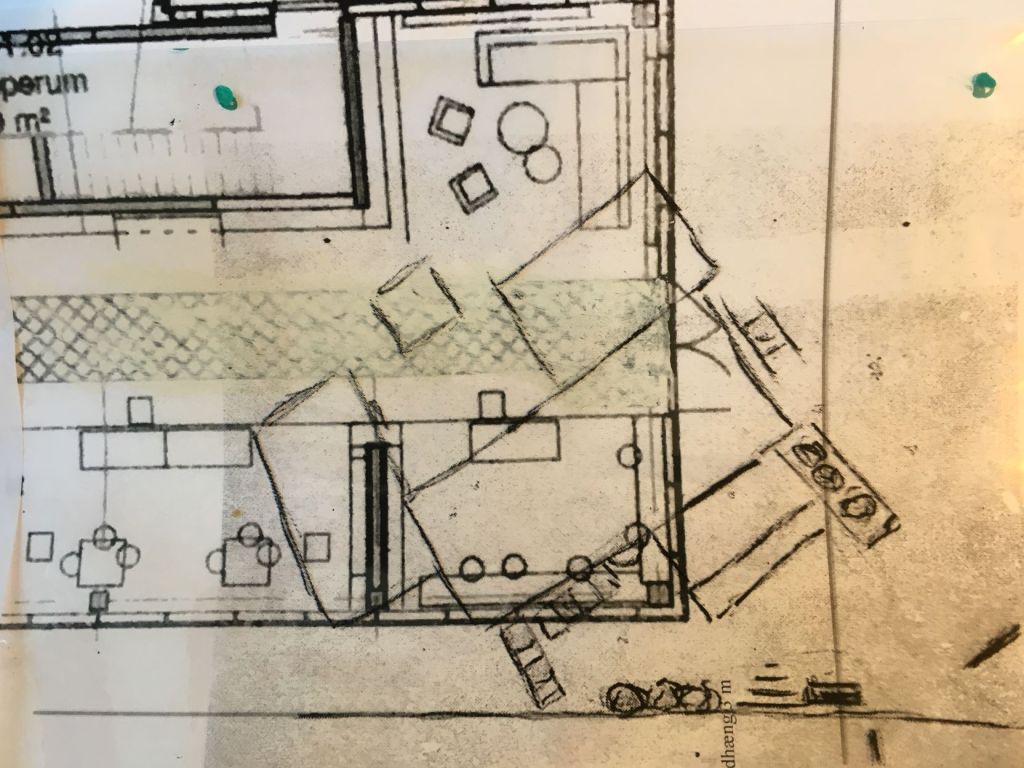


After my departure, the next stage of this project was to take place, consisting in recreating the plan of a no longer existing kindergarten, which in the past was located in the area between today’s library and a new fountain.
Allotment gardens
One of the characteristics of this estate, built in the 1960s and 1970s following the ideas of Le Corbusier, were wide, green spaces between the blocks, with allotment gardens, intended for residents to use. A master plan adopted as part of the revitalization no longer provides for them. The blocks are being gradually demolished and single-family houses surrounded by private gardens will be built in their place. However, during the communal public hearing, which concerned the Dortesvej quarter where Sirids Stue’s apartment is located, the issue of the allotments was raised. These public utility gardens have been recognized as a unique and living cultural heritage of the modernist era, which contributes to strengthening the sense of belonging and social cohesion, food production, and partial self-sufficiency of their users. In addition, the fact that the multi-ethnic group of garden beneficiaries creates a productive and socially sustainable part of society was appreciated. Therefore, it was decided that those that are scheduled to be removed and paved over must be reconstructed elsewhere. These arrangements were enshrined in the text of the social contract. For Sigrids Stue and the local association of the gardens’ users Grønærten, this fact has become the basis for ensuring that this promise is fulfilled. Currently, members of Sigrids Stue’s team, Carl Fraser, and Muhammad Ejle are preparing a design and model of the garden in the new location.


Future
With these types of projects, based on uncertain, discontinuous financing, in the absence of permanent housing security and the need to constantly invest time and energy to involve people on volunteer terms, the issue of the precarity of their survival over a long time arises.
The basic problem that Sigrids Stue is working on is the public space of the estate and the fate of the people residing there. The time in which it conducts its activities coincides with the period when this area is intensively revitalized, and because of this, the local social structure changes significantly. The same happens with ownership relations regarding local land, the balance of power determining the future of this area and its inhabitants.
From an ownership point of view, Gellerupparken resembles a patchwork. It is divided between the Municipality of Aarhus, the Brabrand Housing Cooperative, and a private developer, who has recently purchased parts of it. The Sigrids Stue team adopted a dialogue strategy with all decision-makers. Grete admits: „It is challenging to stay here as an independent art space. To fight for a little bit of space where we could work. So, it is a question of how much space we need for the UdeStue that just measures three x ten meters. This is a space where The UdeStue is now. What is the price for it? Should we make a crowdfunding to buy this little piece of land just to be able to stay here, to be present, and to have some kind of impact? Do we need this spoonful of land? Then you are entering the capitalist way of thinking. Is that really necessary?”. „On the other hand,”, Ambra wonders, „when you are the owner, you have independence. Now we must ask for permission each time.” And Lars jokes at the end of the conversation: „When you come the next time you will see all the containers standing like a tower to occupy as little land as possible.”
